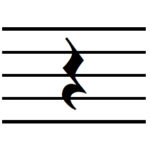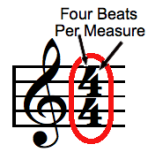Playing piano isn’t only about the music, it’s also about silence. A quarter rest is used to add silence into a piece of music.
When reading sheet music, the composition will contain rests. A rest tells you to stop playing any notes. You are to take a “rest” from playing.
When reading music you will see rests all throughout the music. It is important that you know the difference between a rest and a note and how to apply them in your music.
Let’s take a look at what this rest is, and how to use it.
What’s It Look Like?
This rest sits in the middle of the staff, between the top and bottom staff lines.
Take a look at the picture to see what the rest looks like.
Some teachers say it looks like fish lips. I personally think it looks like a person looking to the left. Whatever you want to use to help you remember it, by all means use it.

When this rest is used in music, it will take up one quarter of the measure that it is in.
In the image below we have quarter notes and rests together in the same measure.
If you divide the measure below into four equal parts, you can see how the each of the notes, and rests, take up about one fourth of the measure. This is an easy visual way to tell how long to hold a quarter rest.

How Long To Hold It Out?

To understand how a rest works, we need to understand time signature.
Time signature is a musical symbol that sits at the beginning of a piece of music. Look back at the image above. See the numbers right next to the treble clef? The 4/4 tells us the time signature of this segment of music.
The top number is what we need to focus on right now.
We see that the top number is a 4. This tells us that there are going to be four beats in each measure.
The time signature of four four would count:
1…..2…..3…..4…..
Listen to the audio…… This tells us how to count measures in 4/4.
Now On To The Important Stuff!
Not that the other wasn’t important, this is what you really need to know when reading rests and music note symbols.
To know what a quarter rest is, think of it like a dollar. The dollar is like one measure of music. There are four quarters in a dollar, so there are four separate beats in a measure.
Each one of the rests, or quarter notes, is like one of the quarters that are in a dollar.
Each rest tells us to stop playing. Total Silence!
Whenever you see this rest, it means to stop playing.
Quick Tip!!
A rest doesn’t mean to let the note before it continue to ring out. When you see a rest, you need to take you hand totally away from the keyboard and stop playing.
Comparing Rests To Quarter Notes
A rest is similar to a note, in that they have a particular value in which you need to hold them out. But like we said before, a quarter note is holding out a note or tone, and a rest is holding out silence.
You can compare a quarter rest to a quarter note because they are held for the same value, a quarter of the measure.
If there are four quarter notes to a measure, then there are going to be four rests to a measure. Take a look at the image below and you can see how quarter notes and rest compare to each other.

Each quarter note is identical in length as the rest. There is one beat for the note, and one beat for the rest. The note is played, while rest is silent!
Now let’s go ahead and do some practice counting using quarter rests.
Practice Counting
Here we have four example of counting with quarter rests. When you count rests, you count the notes with the beat that it receives (1, 2, 3, or 4) an then say “Off” for the rest.
Go ahead……
Here is the first example.
1 2 3 Off

1 2 Off Off

1 Off Off 4

Off 2 3 Off

The quarter rest is a musical note symbol that represents silence in a piece of music. Like the quarter note, the rest is equal to one beat in the measure. If there are four beats in the measure, then the quarter rest gets one beat. Make sure that when you count music rests you say “Off” to give you a cue to stop playing.
Try saying it out loud. Speaking it will help you plant it into memory when it comes time to play. This will really help you to remember to Stop playing.
Go From Quarter Rest Back to Piano Lessons
Back to Home Page
